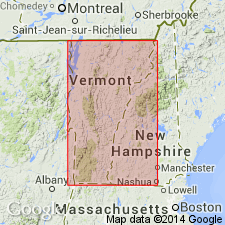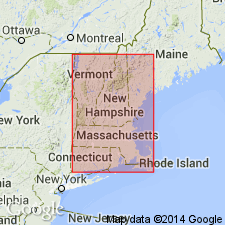
- Usage in publication:
-
- Brigham Hill graywacke
- Modifications:
-
- Areal extent
- AAPG geologic province:
-
- New England province
Summary:
In Green Mountains, westernmost nappe is made up of Cheshire quartzite, of Lower Cambrian age, infolded with a fine-grained graywacke, which has been traced from Essex Junction into southern Quebec, where it is known as Gilman "quartzite." In Vermont, this rock has been named Brigham Hill graywacke.
Source: US geologic names lexicon (USGS Bull. 1200, p. 479, 753).

- Usage in publication:
-
- Brigham Hill graywacke phase
- Modifications:
-
- Principal reference
- Dominant lithology:
-
- Graywacke
- AAPG geologic province:
-
- New England province
Summary:
Pg. 100-101. Brigham Hill graywacke phase. Yellowish to dark-gray very fine-grained graywacke, often with thin bandings of argillaceous material. Phase of Cheshire quartzite, not a formation. Crops out intermittently in Green Mountains from Lake Dunmore north to Quebec border. Makes up Arrowhead Mountain as a klippe thrust onto Upper Cambrian slate. Exposures described. Age designated Early Cambrian.
Named for exposure on Brigham Hill, Essex Twp., Chittenden Co., western VT.
Source: US geologic names lexicon (USGS Bull. 1200, p. 479).
For more information, please contact Nancy Stamm, Geologic Names Committee Secretary.
Asterisk (*) indicates published by U.S. Geological Survey authors.
"No current usage" (†) implies that a name has been abandoned or has fallen into disuse. Former usage and, if known, replacement name given in parentheses ( ).
Slash (/) indicates name conflicts with nomenclatural guidelines (CSN, 1933; ACSN, 1961, 1970; NACSN, 1983, 2005, 2021). May be explained within brackets ([ ]).

